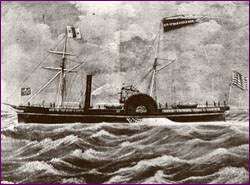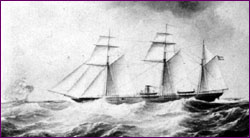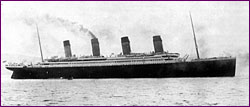
|
 |
|
Part 3 | Back to Part 2 "The Abandoned Shipwreck Act is a paper tiger now," says Peter Hess, an admiralty attorney in Wilmington, Delaware who specializes in litigation involving historic shipwrecks and aircraft salvage. "As found with the Brother Jonathan, the law has no teeth, because a sovereign state that does not have possession of a shipwreck site—in a national park, say—does not have the power to preclude a salvor from doing recovery. The Supreme Court made that clear." Sovereign immunity, which precludes jurisdiction over publicly owned property by individuals or other countries, may still apply to federal if not state governments. The U.S. Navy, for instance, claims ownership of the Confederate warship CSS Alabama, which sunk off the coast of France in 1864, and even went so far as to appropriate without compensation a bronze bell from the ship that a New Jersey antiques dealer had purchased years ago from an English dealer. In December 1998, the Spanish government asked a U.S. federal judge to revoke a salvor's rights to salvage the remains of two centuries-old Spanish warships, the La Galga and the Juno, which went down off the coast of Virginia in 1750 and 1802, respectively. And, of course, France maintains that it owns La Belle. A controversial treaty While these cases are still under litigation, countries that claim lost ships may soon get major support from an international treaty now being drafted at the United Nations Educational, Scientific, and Cultural Organization (UNESCO). The treaty would charge governments with responsibility for jurisdiction and management protection of any non-military ships that are found within 200 miles of their shores and are more than a century old. So, under the treaty, if a sunken Spanish merchant ship were found within 200 miles of New York City, for example, the U.S. would notify Spain to determine their interest in the site. If they had an interest, the two nations would sign a cooperative agreement about managing and protecting the site. If they evinced no interest, the U.S. would still be charged with protecting the site, even if archeologists had no immediate plans to excavate it.
Hess believes there is room for compromise. He cites the finding of the SS Carolina, a passenger steamship sunk by a German U-boat in World War I off the coast of New Jersey. The finder, Hess says, has strived to record everything and make results accessible to the public, including setting up an SS Carolina "virtual museum" on the Web, with historical articles, photographs, and contemporary newspaper articles. "It's the wave of the future," he says, "because we can have information on a wreck site on one repository accessible by anyone, rather than housed in a museum archive that only Ph.D.'s are likely to visit." Carrell feels differently. "The UNESCO treaty is the best chance we have on a worldwide basis to ensure appropriate use for what they call 'underwater cultural heritage,'" she says. "The purpose is not to put private industry out of business but to provide a baseline level of protection and documentation for cultural resources. This type of protection is generally enforced worldwide on land sites. The treaty would simply extend that ethic to the seafloor and underwater cultural heritage."
Of course, the treaty would give France ownership of La Belle, which Carrell helped to excavate for the Texas Historical Commission (see Stories in the Timber). While she admits to a feeling of being pulled in two directions, Carrell says that current negotiations between Texas and France simply would have started sooner rather than later, with the desired result being, she says, "an enhanced archeological and public outcome." Until such time as the treaty comes into effect, however, interested parties must solve their own problems, as Texas and France are now doing. Larry Oaks sums up the THC's position: "The Counsel General of France verbally said that France is not interested in retrieving the resource but only wants to be involved in conservation, exhibits, and loaning. We want to work toward an amicable solution but are unwilling to accept their position without lawyers in maritime law to determine our real interest as far as Texas is concerned." Alas, even among the least disputatious parties, the battle for who owns lost ships wages on. Peter Tyson is Online Producer of NOVA. Photos: (1) Courtesy of Corpus Christi Caller-Times; (3) Corbis/David Lees; (4) Peabody Essex Museum; (5) Courtesy of the Zwaanendael Museum; (6) Collection of the Milwaukee Public Library/Wisconsin Marine Historical Society; (7) Courtesy of San Francisco Maritime NHP, Doris Chase Collection and the California State Lands Commission; (8) Courtesy of William Stanley Hoole Special Collections Library, The University of Alabama; (9) courtesy of Harland and Wolff. Stories in the Timber | Explore the Shipwreck | Who Owns Lost Ships? Buoyancy Brainteasers | Teacher's Guide | Resources | Transcript | Site Map Voyage of Doom Home Editor's Picks | Previous Sites | Join Us/E-mail | TV/Web Schedule About NOVA | Teachers | Site Map | Shop | Jobs | Search | To print PBS Online | NOVA Online | WGBH © | Updated November 2000 |
 The Gold Rush steamer Brother Jonathan
The Gold Rush steamer Brother Jonathan
 The Confederate warship CSS Alabama
The Confederate warship CSS Alabama
 The passenger liner Titanic
The passenger liner Titanic